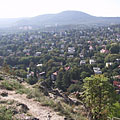(작은 화면 장치에 최적화)

Nagycenk
Where the "Greatest Hungarian" lived
Where the "Greatest Hungarian" lived
Its name is strongly connected with the Széchenyi family, more precisely with István Széchenyi. The most important sight of the city is the neo-classic castle from the Baroque era built by the family. It attracts plenty of visitors with its stately furnished memorial museum and elegant jardin anglais.

The name of the settlement first appeared in a Latin document of an estate purchase in 1291, but in the name of Zenk. During the course of time two settlements have existed next to each other, both of them bearing the name Cenk. They have been given different prefixes to differentiate between them (e.g. Gödörcenk, Tótcenk), and now better known as Kiscenk and Nagycenk. Although the two settlements were united in 1892, they have remained geographically separate from each other.
Just like Fertőd, this settlement used to the property of the Kanizsay family, then to the Nádasdy family. Because of his part in the Wesselényi plot, Ferenc Nádasdy was executed, and the estate became the property of the royal treasury.

After all these events the new owner, Miklós Draskovich, pawned the estate for cash to the wealthy bishop of Győr, György Széchenyi in 1678. Later the estate became the property of the Széchenyi family once and for all, so this enabled them to rise to the Hungarian peerage.

The construction of the Széchenyi castle was started by Antal Széchenyi with the re-building of a former 18th century mansion. This was later converted considerably by the enlightened thinker, Ferenc Széchenyi, who was also the founder of the National Theatre. The best years of the castle fell in the time when it was inherited by his son, István Széchenyi, and Mihály Pollack, the architect, appealed for further expansion and modernization. Among these gas lighting and water closets catered for the convenience of the residents at these times.
István Széchenyi, born in 1791, was called ‘the greatest Hungarian’ by his political rival, Lajos Kossuth, the key figure of the Revolution and War of Independence of 1848-1849. The idea of uniting Pest and Buda and appointing Budapest the capital of the country was first considered by István Széchenyi. It is also true that the construction of the first permanent bridge in the city, the Lánchíd (‘Chainbridge’), the launch of steam shipping on the Danube and several other projects improving Hungary are connected with his name.
특성, 특징
유형:
지방 자치체, 마을
위치:
유럽 (대륙) > 헝가리 (국가) > 서양 헝가리 (관광 지역) > Győr-Moson-Sopron megye (county) (주) > Little Hungarian Plain (Kisalföld) (지리적 영역)
GPS 좌표: 위도 47°36'10", 경도 16°41'55" (N47 36.17 - E16 41.92)
Nagycenk - 포토 갤러리 (32 사진)
Nagycenk - 파노라마 이미지들 (1 사진)
당신은 또한에 관심이있을 수 있습니다 (관련 페이지):
여행 가이드의 목적지:
Nagycenk (32 사진 + 1 파노라마 이미지)
Little Hungarian Plain (Kisalföld) (376 사진 + 5 파노라마 이미지)
Győr-Moson-Sopron megye (county) (433 사진 + 5 파노라마 이미지)
서양 헝가리 (985 사진 + 10 파노라마 이미지)
헝가리 (27,287 사진 + 163 파노라마 이미지)
추가적으로:
(여기에 내부: Győr-Moson-Sopron megye 및 Little Hungarian Plain)
Fertőrákos (68 사진)
Rábaszentandrás (25 사진)
Fertőrákos (68 사진)
Rábaszentandrás (25 사진)
Sopron (57 사진)
Csorna (72 사진)
Fertőd (37 사진 + 2 파노라마 이미지)
Csorna (72 사진)
Fertőd (37 사진 + 2 파노라마 이미지)
Győr (111 사진 + 2 파노라마 이미지)
Győr (111 사진 + 2 파노라마 이미지)
Szany (31 사진)
Szany (31 사진)
여기에 모든 파노라마 사진:
Nagycenk (1 사진)
Little Hungarian Plain (Kisalföld) (5 사진)
Győr-Moson-Sopron megye (county) (5 사진)
서양 헝가리 (10 사진)
헝가리 (163 사진)
유럽 (165 사진)
여기에 모든 일반 사진:
Nagycenk (32 사진)
Little Hungarian Plain (Kisalföld) (376 사진 / 11 갤러리)
Győr-Moson-Sopron megye (county) (433 사진 / 12 갤러리)
서양 헝가리 (985 사진 / 27 갤러리)
헝가리 (27,287 사진 / 462 갤러리)
유럽 (30,494 사진 / 523 갤러리)
친구들과 공유하세요!
기타
회사 소개 - 법적 고지 & 면책 조항 -
모든 권리 보유
- ©2010-2022
Neuronit Creative Studio - Mogyoród / 부다페스트 / 헝가리











